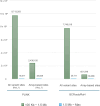Profiling of runs of homozygosity from whole-genome sequence data in Japanese biobank
- PMID: 40175513
- PMCID: PMC12058513
- DOI: 10.1038/s10038-025-01331-3
Profiling of runs of homozygosity from whole-genome sequence data in Japanese biobank
Abstract
Runs of homozygosity (ROHs) are widely observed across the genomes of various species and have been reported to be associated with many traits and common diseases, as well as rare recessive diseases, in human populations. Although single nucleotide polymorphism (SNP) array data have been used in previous studies on ROHs, recent advances in whole-genome sequencing (WGS) technologies and the development of nationwide cohorts/biobanks are making high-density genomic data increasingly available, and it is consequently becoming more feasible to detect ROHs at higher resolution. In the study, we searched for ROHs in two high-coverage WGS datasets from 3552 Japanese individuals and 192 three-generation families (consisting of 1120 family members) in prospective genomic cohorts. The results showed that a considerable number of ROHs, especially short ones that may have remained undetected in conventionally used SNP-array data, can be detected in the WGS data. By filtering out sequencing errors and leveraging pedigree information, longer ROHs are more likely to be detected in WGS data than in SNP-array data. Additionally, we identified gene families within ROH islands that are associated with enriched pathways related to sensory perception of taste and odors, suggesting potential signatures of selection in these key genomic regions.
© 2025. The Author(s).
Conflict of interest statement
Competing interests: The authors declare no competing interests.
Figures



References
-
- Wright S. Coefficients of Inbreeding and Relationship Author (s): Sewall Wright Source: The American Naturalist, Vol. 56, No. 645 (Jul. - Aug., 1922), pp. 330-338 Published by: The University of Chicago Press for The American Society of Naturalists Sta. Am Nat. 1922;56:330–8.
MeSH terms
Supplementary concepts
Grants and funding
LinkOut - more resources
Full Text Sources
